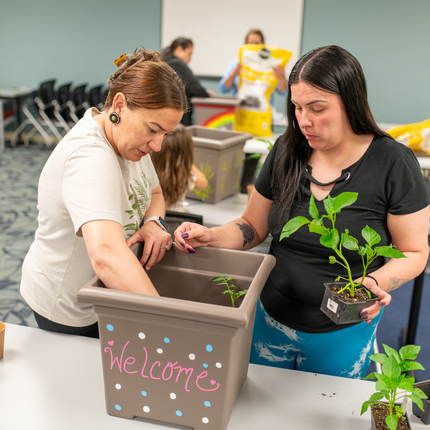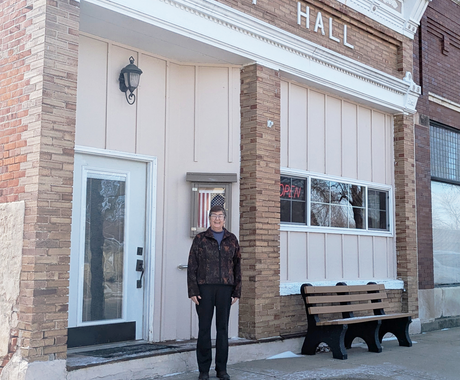Much of the Center for Rural Affairs’ work with Native communities focuses on developing and nurturing food systems. To move forward in these efforts, staff work alongside the Santee Sioux Nation, the Ponca Tribe of Nebraska, the Umóⁿhoⁿ Nation, the Winnebago Tribe, Little Priest Tribal College, and Nebraska Indian Community College (NICC). Together, they support food sovereignty and business development in the communities of Santee, Niobrara, Macy, Walthill, and Winnebago, Nebraska.
The Center offers activities and projects to promote and encourage cultural traditions, improve diets, and support families growing fruits and vegetables. Recently, the partners involved in this work shared their thoughts on what has been accomplished so far and looked ahead to what’s next.
Engaging and empowering communities
The partners agree that the most effective ways to move toward food sovereignty are through offering opportunities for employment and education.
“The way that we engage [community members] is to try and find their interests and offer them different classes to help empower them through education,” said LaVonne Snake, NICC instructor and Winnebago Tribe member.
Lani Moran-Samqua, NICC staff and member of the Umóⁿhoⁿ Nation, said the Center has made a big impact through its actions, including tilling gardens for community members.
“Everyone can say, ‘We need to start a garden, we need to have food sovereignty,’ and when you ask how to do it, no one knows,” said Lani. “So when the Center's programs came along it actually put some movement behind the words.”
Simon Lyons has worked with the Center on these programs as a seasonal staff member and helps community members start and maintain their gardens. He has noticed the work gaining traction in the community.
“This year, people were noticing us more, the work we were doing,” Simon said. “People we didn’t even help last year. The Center gives me the tools to go out and help and work for the community, and I enjoy that a lot.”
Delberta Frazier, former Center summer staff and instructor at Isanti Community Schools, said the collaborative projects they worked on were a game changer. She worked with a University of Nebraska-Lincoln Extension officer and Center staff to put in a garden on Umóⁿhoⁿ Nation land and develop a program called Nation Nourishment. Delberta’s children got involved and received certificates for attending for one year. The following year, the Center hired them as seasonal workers.
“We were all able to garden together,” said Delberta. “I think we put in four gardens together, and now my sons know how to plant Three Sisters gardens (corn, beans, and squash), and they help community members in the summertime tend their gardens and grow food.”
Nepthys Justo, former Center garden coordinator, said the educational opportunities have made a huge difference.
“We’re empowering them and providing a path toward food sovereignty by teaching them how to grow their own food,” she said. “We go around and till gardens and do education throughout the season to keep the gardens going. There’s even classes about how to prepare your food, and if you have a large amount and want to save it, we’ve done canning and freezing classes so that they’re able to carry that on throughout the winter.”
The importance of pursuing food sovereignty
Honoring and preserving culture is a huge part of pursuing food sovereignty in Tribal communities. While the work is not easy, Delberta said, she does it to honor her ancestors who struggled so she could live today.
“I try to live my life every day to the fullest and it’s hard work, but it’s very fulfilling, especially when you’re able to bring it full circle,” she said. “Put it in the ground, bring it home to your family, cook it for your family, and see your family enjoying it; the idea that this is our food, this is what our ancestors ate, this is what they brought to the world.”
She added how important it is to learn from and understand history, part of that being what their ancestors ate.
“I'm always talking to our students about the history of the corn, squash, beans, and bison, of reclaiming our Indigenous wisdom and how powerful and knowledgeable our ancestors were, that they lived here sustainably on this land for thousands of years,” said Delberta. “There’s a better way to do things because our ancestors found a way. We just need to look back into the past and figure that out.”
Self-sufficiency is necessary, and these communities are working toward that goal, said Santee Sioux Nation member and former Center orchard specialist Todd Runnels.
“I think we have some things in place; we have a cattle ranch, we have buffalo, but we need more,” he said. “We need to know how to butcher them and how to store them so people can use them. The same goes with our gardens and our orchard. To me, being sovereign means being self-sufficient, where we have everything we need right here in our community.”
Successful initiatives and programs
Center-sponsored projects with the best results have often been related to education, both community-wide and in schools. Services such as topsoil cultivation, offering workshops on how to harvest food grown in backyard gardens, and more have been received well by community members.
“People notice the work and they know it’s free,” said Simon. “Offering starter plants was a big project. It got people’s attention. And the makerspace helps people create an opportunity for themselves to start their own business. There are a lot of people with good ideas.”
Healthy eating initiatives through Niobrara Public Schools have also been successful and approved by the toughest critics: the kids. Students have been able to come to school over the summer and learn to make healthy, traditional foods for themselves so they don’t have to rely on the adults at home.
They have also had the opportunity to taste different foods throughout the school year, including devoting a day to biting into something crunchy, like apples or carrots, during Farm to School Month.
“After Center staff came to the school for the crunch off, students became very excited,” said Valerie Mullanix, PK-6 principal at Niobrara Public Schools. “They wanted apples for a snack, and many students and parents shared that when they went to the grocery store the kids were picking out their favorite types of apples, sharing what each apple tasted like, and many kids tried a recipe Center staff shared.”
Other students planted gardens at school, had grow towers in their classrooms, or worked on in-classroom activities featuring different vegetables.
“We had a presenter come in and make spinach smoothies, and the kids really liked them,” said Nepthys. “Most of them never thought about eating spinach before, and now they’re trying new foods because they’re available in our classroom.”
Community-wide impacts of the Center’s services and resources
“The Center’s seminar on healthy living gave more of a perspective than we usually get here,” said Lani. “They don’t just say, ‘Don’t do sugar, instead have all this artificial sweetener.’ When they came and talked about artificial sweeteners, it just proved that that’s not healthy living, either. It really resonated with my 10-year-old. If it has Red Dye 40 in it he does not eat it. And he’s getting on me, so we’re slowly weaning off all of that stuff. I was really appreciative of that.”
Initially, participants consisted of family members of the organizers or close friends, but the services have begun to reach a wider audience, and more people are becoming curious.
“I can see people opening up more,” said LaVonne. “I can see where it is benefiting the community. It’s hard to operate these different programs in Native communities because you have to be a part of the community for them to be receptive or else you have to be able to be respectful of their customs. It takes a while to establish those relationships.”
“It’s a slow process,” added Lani. “It takes one person to try it, then they talk to two people and they tell two people, and so on, and if it’s good then they’ll join. I think that’s where we’re at in the process.”
Future hopes for projects between the Center and Native communities
Community members envision a variety of projects that could help them continue to work toward food sovereignty. Everything from dedicating space for a centrally located orchard with a water source to receiving more training rank at the top of Todd’s list.
“It’d be helpful to have more training on how to take care of things,” he said. “How to prevent insects and pests and plant diseases that can affect the way the crops grow; there’s a lot of issues that I don’t know about. Right now, the trees don't produce anything, but someday the fruit will be usable, and I hope the members of the community will take care of and use the fruit.”
Many would like to see garden expansion happen in their communities. Ezra Lyons, Center summer staff and member of the Umóⁿhoⁿ Nation, offered the idea that larger gardens equal healthier living.
“I hope we continue to go bigger every year and have our gardening and tilling lists just keep growing until each and every one of our Tribal members understand that this is a better way to live instead of eating things that we don’t know where they come from,” said Ezra. “If you grow food right in your own yard, you know where it comes from so you know it’s good for you. I see that for our people, a healthier food system.”
Networking has also been an important factor in moving forward with these projects and partnerships. It could lead to a way back to more traditional ways, which may be the answer to many of the issues they face.
“When we co-sponsor these events and bring all these people together, that's helping to build networking where people are going to share their old seeds and stuff like that,” LaVonne said. “It’s not something you can just come out and ask people to do. It’s something you have to work on and build. The thing we are trying to do is build our native seed stocks up to try to return to a more traditional diet as a way of treating our rampant diabetes and cancer rates. I think it’s really important to return to our traditional foods.”
To learn more about the Center’s work alongside Native communities, visit cfra.org/native-communities.
Feature photo: Miranda Roberts, Center community foods associate, helps plant tomato and pepper plants with a goal of growing ingredients to make salsa. This workshop was held in Santee. | Photo by Kylie Kai





